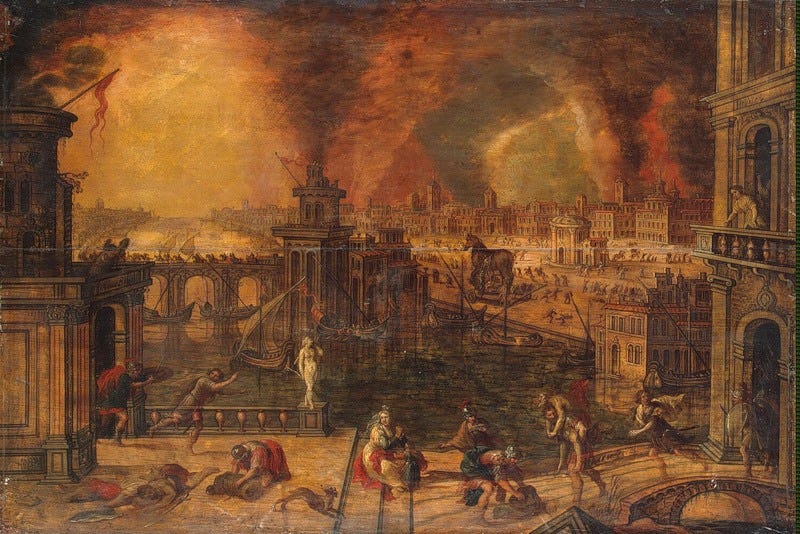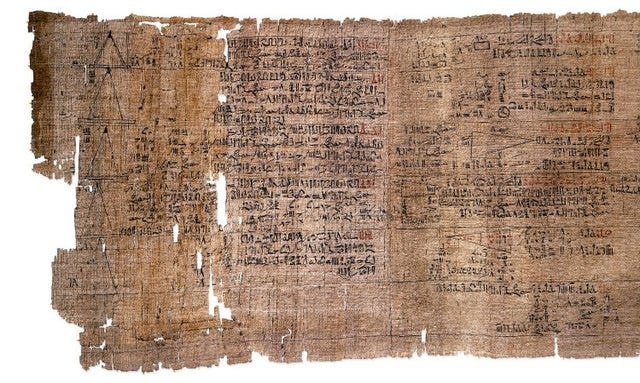Ancient/Now - February 17th
Demanding the return of the Rosetta Stone, climate crisis and the fall of the Hittite Empire, a rave concert at Hatshepsut's mortuary temple, and more
Zahi Hawass continues to demand that the Rosetta Stone be returned to Egypt

Who owns the Rosetta Stone, that vaunted object that helped Champollion crack the hieroglyphic code? Is it Egypt’s national patrimony or the world’s shared cultural heritage or both? Egypt has long petitioned the United Kingdom and the British Museum for the return of the Rosetta Stone. They have redoubled their efforts in the current climate of the repatriation of artifacts by museums whose collections were formed by colonialist powers, but the British Museum continues to resist Egypt’s appeals and some scholars have recently argued against the return of the artifact full-stop.
In a recent article on AhramOnline, Egyptologist Zahi Hawass responded to an article by emeritus professor of Mediterranean history at the University of Cambridge, David Abulafia, published by The Spectator last December entitled “Why the Rosetta Stone shouldn’t be returned to Egypt.” Abulafia argues that the Rosetta Stone is a “damaged” stone artifact that pales in comparison to the treasures of Tutankhamen, with its “humdrum” inscriptions in hieroglyphs, Demotic, and Greek that were inscribed in the Ptolemaic era when “native dynasties” didn’t even rule Egypt. The stone was, he adds, treated as detritus by the Mamluk rulers of medieval Egypt, who used it to help form the foundation of a fortress in the Nile Delta. He continues, not bothering to temper the colonial, patriarchal, and Orientalist overtones,
The damaged black stone had been carted from its unknown place of origin to the foundations of a fortress at Rosetta or Rashida in the Nile Delta during the reign of Qaitbay, one of the Mamluk sultans of late medieval Egypt. These Mamluks were former Circassian slaves who had been exported from the Black Sea, mainly by Genoese merchants. Male Circassians with big muscles entered the palace guard and sometimes gained supreme power, Qaitbay being an excellent example. Female Circassians were famous for their beauty and might end up as sultanas or as sex slaves.
His use of eyebrow-raising vocabulary aside, Abulafia essentially concludes that “[f]or most of its existence it had no owners at all. The British Museum needs to hold on to this discarded piece of ancient rubbish.” Hawass’s deservedly indignant response (although somewhat rambling in places, hyperbolic, and quite patriarchal itself in many respects), mainly objects to Abulafia’s attempt to divorce the Rosetta Stone’s history from Egypt:
I agree with Abulafia that the history of the Rosetta Stone is not local but rather global history. However, I still believe that it would be fair to return the stone to Egypt. The British Museum has thousands of artefacts on display and in its reserves. We are not requesting any other artefact, but we need the Rosetta Stone because it is a symbol of Egypt and as such should be in Egypt.
We feel Hawass is right. The significance of the Rosetta Stone’s role in history—especially the history of Egypt—shouldn’t be dismissed. The discovery of the Rosetta Stone and the subsequent decipherment of the ancient Egyptian language it made possible played an important role in the history of Egypt and the foundations of Egyptology. The intellectual arguments justifying the British Museum’s keeping the Rosetta Stone are tenuous at best and are hard to take seriously because they are all made from a refusal to make a simple acknowledgement: that returning it to Egypt is the right thing to do.
Devastating drought led to climate crisis and decline of the Hittite empire
Heads up! A new article in Nature just freaked out all the Late Bronze Age nerds, and it’s all about three thousand year old climate change. The ways in which climate change can influence the course of human events is a timely topic given the current human-petrochemical-induced climate change of the 21st century. Well, this new study provides real insight into how bad environmental conditions actually got and how it led to the decline and collapse of the Hittite empire (based in the area of modern-day central Anatolia, Turkey) around 1200 BCE. The new research presented in the article—including the use of dendrochronology from juniper trees—adds to our knowledge about the Bronze Age collapse. Both the quality and quantity of scientific data on the environment of this time period from varied sources that we now have strengthens the ancient written and material culture evidence of a significant drought in the Mediterranean.
Put this mega-drought together with other political and geothermal events, and well, you’ve got yourself a hell of a time of destabilization. Government collapse. Mass migration. Dogs and cats living together. You get the picture. As we know from the warnings modern scientists have given to the public for decades now, climate change can create a domino effect leading to famine, drought, mass movements of people, political upheavals, and the general collapse of social systems. A social shit-show! Specialists in the period of the Bronze Age collapse like Egyptologist Eric Cline, author of 1177 B.C.: The Year Civilization Collapsed, have previously suggested that drought was a major contributing factor to the multiple catastrophes that collided across the Mediterranean at this time and this study further supports the scientific evidence for that assessment. Why it made so many scholars so angry on Twitter still confuses us…
Did air pollution inspire Impressionism?

Ask someone born and raised in Los Angeles what that brown cloud hanging over downtown is and they might tell you it’s “the marine layer,” even though it is plainly smog and pollution. Well, we humans have been here before. Indeed, when Monet painted his famous Houses of Parliament series, some are now wondering if the “effect of fog” was really just polluted air. Beautiful, lovely, postcard-perfect, polluted air. A new study by the Proceedings of the National Academy of Sciences studied select paintings by Claude Monet and J.M.W. Turner because they often painted the same places multiple times and their lives roughly coincided with the rise of industrialization and polluted air in Europe. We learn that:
While the two scientists present a compelling case (they found a 61% correlation rate between smog and contrast in the paintings), they also note other hypotheses that could explain Turner and Monet’s artistic shift toward blurred lines and white hues: Was Turner painting bright skies because his society was becoming more and more interested in astronomy? Was Monet blurring his landscapes because he was copying Turner’s style, or because his vision became impaired as he got older?
Although attempting to precisely determine the factors that influenced these artists’ work isn’t possible, this study provides an interesting hypothesis on one possible influence on their art. We must remind ourselves, perhaps, how beautiful unregulated capitalism really is…
How have ancient Egyptian papyri survived?
In a recent post on the British Museum’s blog, conservator Helen Sharp shares her expert insights on how examples of ancient Egyptian papyrus survived through the millennia and how modern conservators must work to preserve it after it finds its way into a collection. While some funerary papyri were made specifically for funerary contexts and therefore often survive intact and in good condition, other papyri (like the Rhind Mathematical Papyrus) were meant to be used often and show signs of wear and tear and repair. One thing is for sure: papyri survive because of dry conditions; most were found in tombs or in desert habitation sites. Check out this blog post for a behind-the-scenes look—including some great photos!—at the painstaking work of preserving papyri.
Rave concert at Hatshepsut’s mortuary temple?!
On February 13th a Cercle concert by famed DJ duo Adriatique took place at Hatshepsut’s mortuary temple at Deir el-Bahri (near Luxor). The Ministry of Antiquities and Tourism and Egyptian Tourism Authority organized event had the aim of bringing more tourism to Egypt, and drew some 3,000 music fans to the ancient temple to laugh and jump and reverberate all over the damn place. Why such a spectacle?
[Officials] also highlighted that the events constitute “promotion” for Egypt. The event’s digital broadcast on Cercle’s social media, which has over 1.3 million followers worldwide, was also argued to be a tool with the potential to boost the country’s various destinations and attractions.
Public reactions to the event on social media ran the gamut from jealousy, to curiosity, to horror and outrage. From an archaeological perspective, there is certainly reason to be gravely concerned at the possible damage that could be caused by the party atmosphere of a rave concert, sound vibrations from loud music, and setting up the stage, sound, and lighting equipment. The Hatshepsut Temple courtyard has been used for other massive events, including a recent Aida opera attended by 4,000 spectators. The architecture lends itself to such spectacles. Egyptologists argue that this terraced structure was meant to be a ritual stage for pharaonic displays to a massive ancient populace. This won’t be the last such event either now that the Ministry of Tourism is linked with the Ministry of Antiquities, as agendas of promotion will overrule agendas of protection. It says a great deal about our own cultural biases, however, that people freaked out over the rave and not the opera. Because, really, what’s the difference?
Hitpoints & History digital conference will feature Kara as a keynote speaker
Kara’s keynote lecture for the Hitpoints & History digital conference on Saturday, March 4, 2023 will feature a look at how Cleopatra, one of the most infamous women to rule the ancient world, is portrayed in the popular video game Assassin’s Creed. The historical Cleopatra used her sexuality—and her money—to build alliances with warlords of the Roman Empire. Ancient Roman propaganda aggrandized her ultimate failure and death, painting her as a selfish woman who lived a life of luxury and seduced powerful men, ultimately abandoning her people by committing suicide. This Roman portrait of Cleopatra endures today in popular culture, including in video games like Assassin’s Creed. Time to bring this misogynist image down, Kara says…
About Hitpoints & History:
Play your way through the ancient world at Hitpoints & History, a virtual archaeogaming conference connecting academics, professionals, and gamers. Join us March 4th and 5th as we explore the open world of archaeogaming through livestreams, workshops, and collaborative gaming events. Presenters include Kara Cooney, Andrew Reinhard, Betty Robertson, and more! To find out more, buy tickets, or submit a presentation proposal, head over to hitpointscon.com.











I didn’t get my invite to the rave 😢
Lost in the mail ?